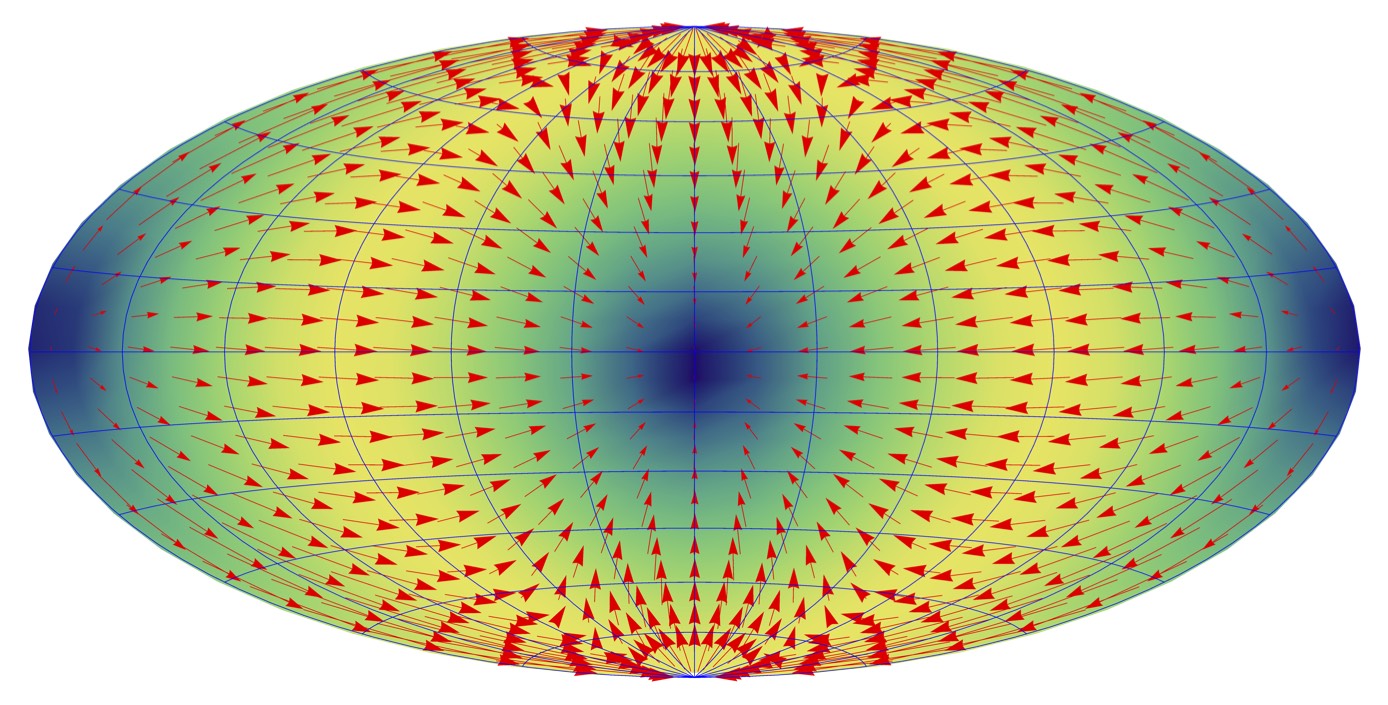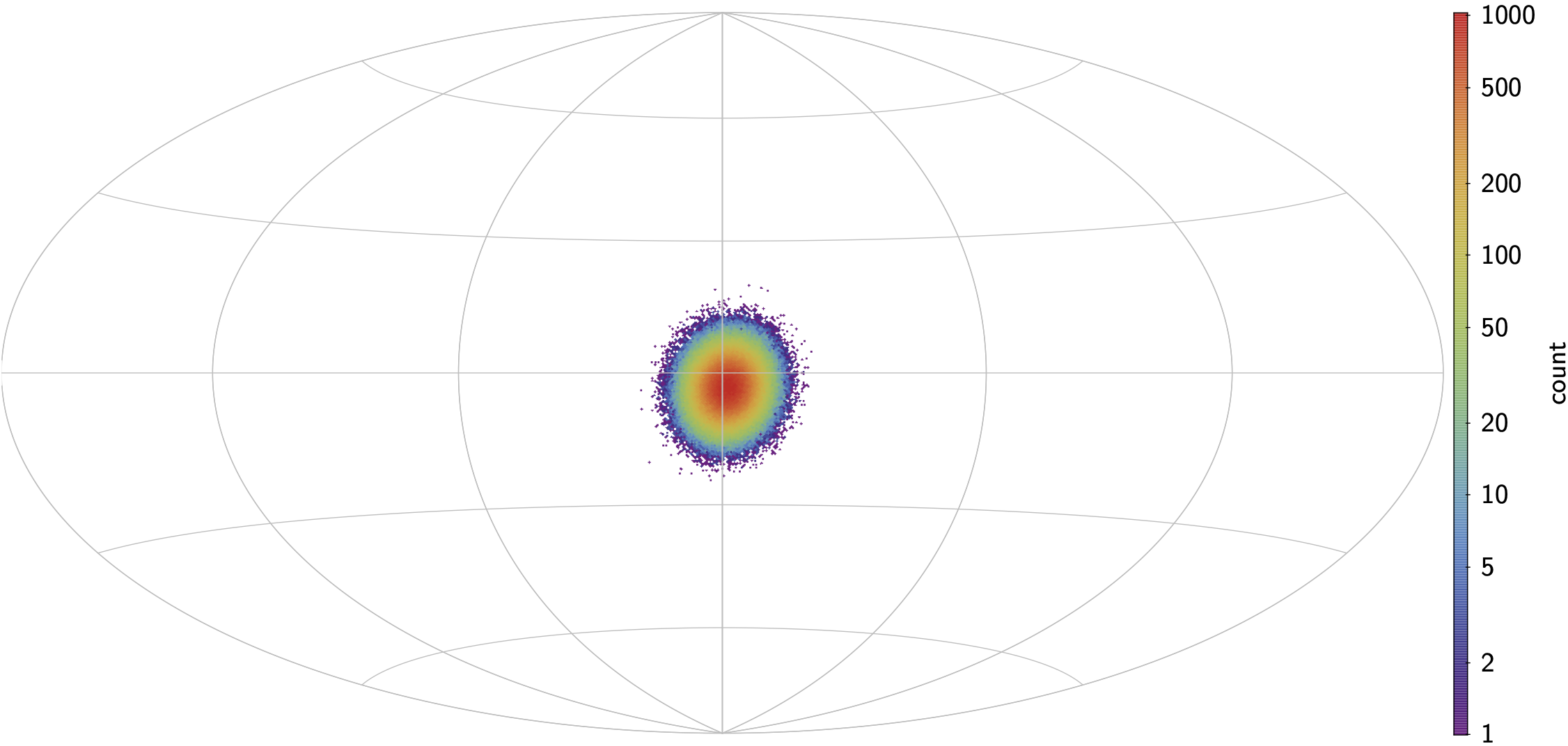Gaia EDR3 - Acceleration of the solar system - Gaia
Gaia's measurement of the solar system acceleration with respect to the distant universe
With the high quality of Gaia EDR3, Gaia is for the first time capable of observing the tiny effect of the acceleration of the solar system with respect to the distant universe. This tiny effect is not measured directly but deduced from the aberration of light seen in 1.6 million quasars observed by Gaia. These quasars are extragalactic sources at extremely large distances and are used to generate an inertial reference frame, the third realisation of the Gaia Celestial Reference Frame (Gaia-CRF3).
Nowadays it is well known that the apparent position of a star viewed from the Earth depends on the Earth's velocity. This effect is called aberration and was discovered by James Bradley in 1727. This phenomenon produces apparent shifts of the directions of celestial objects dependent on the velocity of the observer. It causes objects to appear to be displaced towards the direction of motion of the observer compared to when the observer is stationary.
As an example of this phenomenon, imagine you are standing in the rain with an umbrella and rain is pouring down from the sky. When you start running, the rain suddenly seems to be coming at you from an angle. This is your viewpoint while running. For someone else looking at you running in the rain, the rain still pours down from the sky vertically. The person running in the rain thus observes the rain coming from a different direction than the direction perceived by the stationary observer. This difference in observation is the aberration.
Figure 1: Visualisation of the aberration effect. (a) Person in the rain – standing still. The rain comes down vertically. (b) Person running in the rain. The same rain seems to be coming from an angle. This is the viewpoint from the person running. (c) Person running in the rain, as observed by someone else standing still. The rain comes down vertically. Image credit: ESA/Gaia/DPAC – CC BY-SA 3.0 IGO
The aberration effect also applies to the observations taken by Gaia of the distant quasars, many of them billions of lightyears away from the Sun and the Milky Way. If we define our reference frame as being at rest relative to 1.6 million quasars observed by Gaia, then all objects seen by Gaia experience aberration due to Gaia’s orbit around the Sun, the motion of the Sun relative to the solar system barycentre, the motion of the solar system barycentre around the Galactic centre, and the motion of the Milky Way relative to the quasar reference frame.
When removing the aberration from Gaia’s motion around the solar system barycentre, the residual aberration for each source is dominated by a large shift caused by the velocity of the solar system barycentre with respect to the distant universe. However, due to the motion of the solar system barycentre inside the Milky Way, this large shift embeds a tiny linear change with time due to the acceleration of the solar system barycentre relative to the rest-frame of the quasars. This effect was first discussed by John Pond in 1833 and has never been detected observationally in the optical. The slow linear change of the residual aberration produces a systematic pattern in the measured proper motions of quasars on the sky.
Visualisation 1: Shown here is the aberration-induced proper-motion field in the form of little arrows, on a rotating sky sphere in orthographic projection. The rotation enables to see the entire sphere and the variation in the arrows. Credit: ESA/Gaia/DPAC - CC BY-SA 3.0 IGO.
With the high quality of the astrometric data of Gaia EDR3, which is based on 34 months of spacecraft observations, this predicted systematic pattern was successfully detected.
Figure 2: The pattern of quasar proper motions due to the measured acceleration, i.e. slightly offset from the galactic centre, and given in galactic coordinates. The galactic centre is in the middle at l=0 deg. The Hammer-Aitoff projection allows to see the entire sky. The arrows represent the size and direction of the acceleration, and the underlying colour represents the size as well. Image credit: ESA/Gaia/DPAC - CC BY-SA 3.0 IGO
In the Gaia EDR3 science verification paper "Gaia Early Data Release 3: Acceleration of the solar system from Gaia astrometry" it was found that the amplitude of the pattern is about 5 micro-arcsecond per year which corresponds to an acceleration of about 0.23 nanometer/s2 towards the point with celestial coordinates (alpha ~ 269.1 deg, delta ~ -31.6 deg), within a few degrees from the Galactic Centre.
In one second of time, this tiny acceleration causes a deflection of the solar system’s trajectory of about 0.1 nanometer towards the galactic centre, some 26,000 light years away. Not to be forgotten here is that the solar system barycentre is moving around the galactic centre with a velocity of about 220 km/s, and that the combination of a large velocity with a pull from the galactic centre results in an orbit. To put things into perspective: the acceleration of the Sun towards the barycenter of the solar system is up to 250 nanometer/s2 (so ~1000 times bigger).
Figure 3: A visualisation of the error ellipse of the estimated direction of the acceleration estimate in galactic coordinates. According to Gaia EDR3, the chance that the true value of the acceleration lies within the red area is 50%, within the yellow ring 90%, within the light blue ring 99%, and within the dark blue ring almost 100%. Image credit: Gaia Collaboration, S. Klioner, et al. A&A 2020
The found measurement of the acceleration of the solar system is in general agreement with theoretical expectations from the supposed nearly circular orbit of the solar system barycentre within the Galaxy. The apparent proper motions of the quasars thus show that the acceleration of our solar system is pointing roughly towards the centre of our Milky Way, as expected. Interestingly, the Gaia measurement is absolutely independent of the nature of the acceleration and gives, in a model-independent way, the acceleration of the solar system barycentre with respect to the distant universe.
The prospects of further improving this measurement are good. This result was obtained using the Gaia EDR3 catalogue. This catalogue is based on 34 months of data. With more years of data, which are already in the pipeline for future data releases, the proper motions are expected to further increase in precision, which will in turn help refine this measurement. The systematic proper motion field of quasars induced by the measured acceleration is also visualised with Gaia Sky videos. These can be found below:
Visualisation 2: The positions of 3000 quasars are shown (not the real ones observed by Gaia but quasars with positions randomly distributed over the sky). Then the proper motion vectors are shown. Finally, the motion is activated running 25,000 trillion (or 2.5*1016) times faster than in reality. The quasars appear to move closer towards the direction of acceleration, close to the galactic centre. This is a side-effect of the extremely exaggerated movements to allow demonstrating the aberration effect. Credit: ESA/Gaia/DPAC - CC BY-SA 3.0 IGO.
Visualisation 3: A zoom of Visualisation 2, which shows the positions of 3000 quasars (not the real ones observed by Gaia but quasars with positions randomly distributed over the sky). Then the proper motion vectors are shown. Finally, the motion is activated running 25,000 trillion (or 2.5*1016) times faster than in reality. The quasars appear to move closer towards the direction of acceleration, close to the galactic centre. This is a side-effect of the extremely exaggerated movements to allow demonstrating the aberration effect. Credit: ESA/Gaia/DPAC - CC BY-SA 3.0 IGO.
Further reading: Gaia Early Data Release 3: the acceleration of the solar system, Gaia Collaboration, S. Klioner, et al. A&A 2020
Video 1: Antonella Vallenari - How did you use the effect of aberration to measure the acceleration of the solar system with Gaia? Credit: ESA/Gaia/DPAC
Acknowledgements for the images and visualisations:
Figure 1: Created by T. Roegiers
Figure 2: Created by Sergei Klioner, TU Dresden, Germany
Visualisation 1: F. Mignard, OCA/Nice, France
Visualisation 2: S. Jordan, T. Sagristà, created with Gaia Sky (http://www.zah.uni-heidelberg.de/gaia/outreach/gaiasky) Based on Gaia Collaboration, Klioner et al., 2020, "Gaia Early Data Release 3 Acceleration of the solar system from Gaia astrometry", Astronomy and Astrophysics, in press
Visualisation 3: S. Jordan, T. Sagristà, created with Gaia Sky (http://www.zah.uni-heidelberg.de/gaia/outreach/gaiasky) Based on Gaia Collaboration, Klioner et al., 2020, "Gaia Early Data Release 3 Acceleration of the solar system from Gaia astrometry", Astronomy and Astrophysics, in press
Video 1: This video was created by Antonella Vallenari, Anthony Brown and Eduard Masana.
Published 3 December 2020 – Credit: ESA/Gaia/DPAC
- Removed a total of (16) style text-align:center;
- Removed a total of (10) style text-align:justify;
- Converted a total of (4) youtube to youtube-nocookie.
More Gaia EDR3 stories on Cosmos
Following the journey of stars across the sky
The acceleration of the solar system with respect to the distant universe
A dive into the Magellanic Clouds
Gaia Catalogue of Nearby Stars
Gaia EDR3 releases on SCI.ESA.INT
Gaia's new data takes us to the Milky Way and beyond
Video release: Orbits of nearby stars around the galaxy
Video release: Measuring the acceleration of the Solar System with Gaia
Video release: Bridge of stars
Video release: Gaia's stellar motion for the next 1.6 million years
Image release: Gaia's stellar motion for the next 400 thousand years
Image release: Gaia's view of the Milky Way's neighbouring galaxies
Image release: Gaia's early data release 3 in numbers
Image release: The density of stars from Gaia's early data release 3 - equirectangular projection
Image release: The density of stars from Gaia's early data release 3
Image release: The colour of the sky from Gaia's early data release 3 - equirectangular projection
Image release: The colour of the sky from Gaia's early data release 3
Gaia EDR3 Release on ESA.INT








































 Sign in
Sign in
 Science & Technology
Science & Technology




